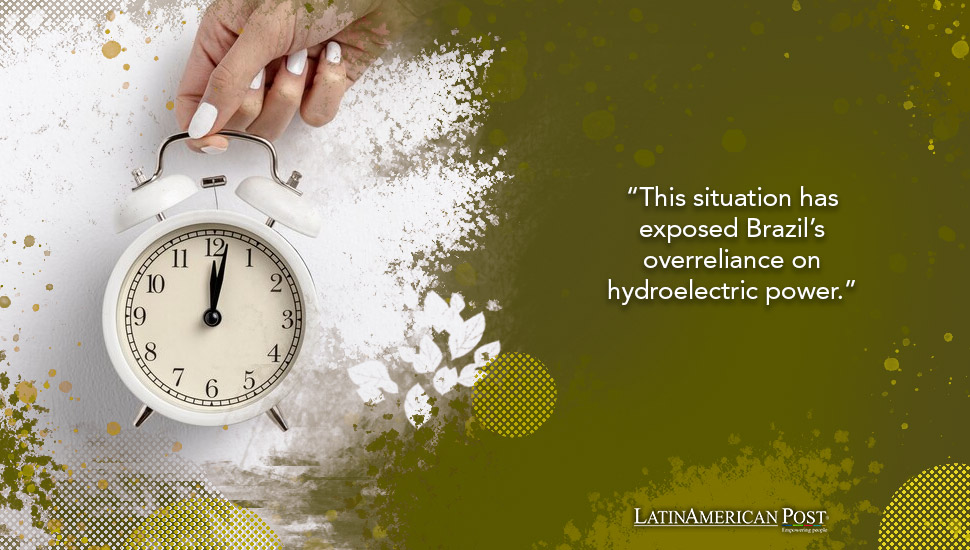Daylight Saving Time Won’t Fix Brazil’s Energy Crisis

As droughts continue to disrupt hydroelectric power across Latin America, countries like Brazil face tough decisions on whether Daylight Saving Time is the solution or merely a distraction from the more profound energy challenges they must address.
Brazil’s Return to Daylight Saving Time
Brazil is facing one of its worst energy crises in recent history, spurred by an intense drought that has severely impacted its hydroelectric power plants, responsible for supplying more than half of its electricity. With reservoir levels at critical lows, Brazilian energy authorities have considered reintroducing Daylight Saving Time (DST) to reduce peak-hour electricity consumption. This potential policy shift, which would require approval from President Luiz Inacio Lula da Silva, has reignited debates on whether DST is an effective solution to the country’s energy woes or merely a short-term band-aid that distracts from the real issues at hand.
Brazil’s energy challenges are not unique, however. Across Latin America, countries like Mexico, Chile, and Colombia are grappling with similar energy crises caused by drought, aging infrastructure, and increasing demand. While DST might offer temporary relief by shifting electricity consumption to daylight hours, the broader question remains: Can this policy truly address the region’s long-term energy challenges?
In this article, we’ll explore Brazil’s current energy crisis, examine the impact of DST, and look at how other Latin American nations face similar energy struggles. We will also analyze successful approaches implemented by countries like Uruguay and Costa Rica and propose potential long-term solutions for Brazil and its neighbors.
The Impact of Drought on Brazil’s Hydroelectric Power
Brazil, the largest economy in Latin America, has long relied on its vast network of rivers and reservoirs to generate electricity through hydroelectric power. This system has been the backbone of the country’s energy infrastructure for decades. Still, as climate change intensifies, this once-reliable energy source is becoming increasingly vulnerable to droughts and erratic rainfall patterns.
In 2024, Brazil’s southeastern and center-west regions, where many of the country’s largest hydroelectric plants are located, experienced record-low rainfall, leading to drastic drops in reservoir levels. By the end of September, water levels at these critical facilities had fallen below 50%, prompting warnings from energy officials that the country might face blackouts and further energy price hikes. With the country’s energy demand rising, Brazil has been forced to import energy from neighboring countries, increasing its dependence on more expensive fossil fuels and driving up energy costs for consumers.
This situation has exposed Brazil’s overreliance on hydroelectric power and highlighted the need for a more diversified energy mix. Despite recent investments in wind and solar power, these renewable sources have not yet reached the scale needed to offset the declining output from hydroelectric plants. As Brazil scrambles to find solutions, some officials have proposed bringing back DST, a policy that was abolished in 2019 by former President Jair Bolsonaro.
Daylight Saving Time, which shifts the clocks forward by one hour during the summer months, is designed to use daylight better and reduce electricity consumption during the evening peak hours. Proponents argue that reinstating DST could help ease the strain on the energy grid and provide some immediate relief during the current crisis. However, the effectiveness of this policy remains uncertain, and many experts question whether it is the right solution for Brazil’s long-term energy challenges.
Daylight Saving Time: A Temporary Fix or Long-Term Solution?
Daylight Saving Time has been a contentious issue in Brazil for years. First introduced in the country in 1931, DST was used intermittently until it was abolished in 2019. At the time, then-President Bolsonaro argued that the policy no longer benefited the energy sector and caused disruptions to people’s daily routines. In 2019, the Brazilian government claimed that the energy savings from DST had become negligible due to changes in consumption patterns and the increasing use of energy-efficient technologies.
As Brazil faces a critical energy shortage, the idea of bringing back DST has gained renewed attention. Supporters argue that by extending daylight hours in the evening, the policy could reduce the need for artificial lighting and air conditioning during peak times, thereby easing the pressure on the energy grid. The national grid operator ONS has already endorsed the return of DST, and an energy committee representing various stakeholders has given the policy the green light.
Bars and restaurants, particularly those in Brazil’s vibrant urban centers, have supported DST. The local association Abrasel has estimated that the extra hour of daylight could increase business during the early evening, boosting revenue by at least 10%. For an industry still recovering from the economic impact of the COVID-19 pandemic, this potential boost in sales is seen as a significant benefit.
However, DST’s return is not without its challenges. Airlines and the tourism sector have expressed concerns about the logistical complications of shifting flight schedules, particularly for international routes. Adjusting flight times and coordinating crew schedules could result in additional costs for airlines, complicate operations, and potentially lead to higher ticket prices for consumers.
Critics of DST also argue that the policy is a short-term fix that doesn’t address the underlying issues in Brazil’s energy infrastructure. While DST may provide some relief during the summer months, it is unlikely to solve the more significant problem of Brazil’s overreliance on hydroelectric power and its vulnerability to drought. To ensure long-term energy security, Brazil will need to invest in a more diversified energy mix and improve the resilience of its infrastructure to climate-related shocks.
Latin America’s Energy Challenges
Brazil is not alone in its energy struggles. Across Latin America, countries that rely on hydroelectric power are facing similar challenges as climate change exacerbates drought conditions and disrupts energy production. From Mexico to Chile, nations across the region are grappling with energy shortages, rising electricity costs, and increasing demand.
In Mexico, recurring energy crises have been caused by aging infrastructure, rising demand, and prolonged droughts in the northern regions. Despite efforts to expand the country’s renewable energy sector, particularly in solar and wind power, progress has been slow, and the government continues to rely heavily on fossil fuels. This dependence has left Mexico vulnerable to price fluctuations in the global energy market and has contributed to rising consumer electricity costs.
Chile, a country known for its advanced renewable energy sector, has faced setbacks due to drought. While Chile has made significant progress in developing solar power, particularly in the Atacama Desert, the country still relies on hydroelectric power for considerable energy needs. A severe drought in 2021 and 2022 depleted water reserves in critical regions, forcing the government to rely more heavily on thermal power generation, which increased greenhouse gas emissions and raised electricity prices.
In Colombia, fluctuating rainfall patterns have caused periodic energy shortages as the country’s hydroelectric plants struggle to meet demand. In 2022, a severe drought reduced water levels in critical reservoirs, prompting the government to issue emergency energy-saving measures and encouraging consumers to reduce electricity consumption. While Colombia has made some progress in diversifying its energy mix with investments in wind and solar projects, the transition has been slow, and the country remains vulnerable to climate-related disruptions.
These regional struggles highlight the need for Latin American countries to rethink their energy strategies and invest in more resilient infrastructure. While policies like DST may offer temporary relief, they do not address the root causes of the energy crisis: an overreliance on hydroelectric power and a failure to adequately invest in alternative energy sources.
Success Stories and Lessons from Other Latin Nations
While many Latin American countries are struggling with energy shortages and climate-related disruptions, there are also examples of nations that have successfully implemented policies to address these challenges.
Uruguay, for example, has emerged as a leader in renewable energy. The country now generates more than 98% of its electricity from renewable sources, including wind, solar, and hydroelectric power. This remarkable achievement was made possible by strong government support, investment in infrastructure, and collaboration with private companies. Uruguay’s energy transformation has made the country more resilient to climate change, reduced energy costs for consumers, and helped stabilize the national grid.
Costa Rica is another Latin American success story regarding renewable energy. The country has long been a global leader in sustainability, with nearly 100% of its electricity coming from renewable sources. Costa Rica’s energy mix includes hydropower, geothermal, wind, and solar energy, allowing the country to maintain a stable and sustainable energy system. The government has also implemented public awareness campaigns and incentive programs to encourage energy conservation and efficiency, reducing the country’s reliance on fossil fuels.
Both Uruguay and Costa Rica offer valuable lessons for other Latin American countries, including Brazil. Their success demonstrates that it is possible to build resilient and sustainable energy systems by investing in renewable energy and implementing policies that promote energy efficiency and conservation. For Brazil, the reintroduction of DST could be part of a broader strategy to reduce energy consumption, but it should not be viewed as a standalone solution. Instead, Brazil must prioritize investment in renewable energy, improve the efficiency of its energy infrastructure, and develop long-term strategies to mitigate the impact of climate change on its energy supply.
A Region at a Crossroads
Latin America finds itself at a critical juncture in its energy transition. The challenges posed by climate change, droughts, and energy shortages are not unique to Brazil but reflect a broader regional issue that demands coordinated action and innovative solutions. Countries like Uruguay and Costa Rica have shown that building resilient and sustainable energy systems is possible, but for others, the path forward remains uncertain.
As Brazil considers the return of daylight saving time, it must also confront the deeper structural issues that have left its energy system vulnerable to climate shocks. In doing so, Brazil could address its immediate energy crisis and set an example for other nations in the region. The future of Latin America’s energy lies in innovation, collaboration, and
A commitment to sustainability.
While daylight saving time might offer a temporary reprieve, more comprehensive measures are clearly needed to ensure energy security across the region. For Brazil, this means accelerating investments in renewable energy, improving energy infrastructure, and promoting energy efficiency across industries and households. Diversifying the energy mix to reduce reliance on hydroelectric power is crucial, especially as climate change continues to create unpredictable weather patterns that disrupt water resources.
Furthermore, collaboration among Latin American countries will be essential. Shared experiences and challenges mean that countries in the region can learn from each other’s successes and failures. Brazil can look to Uruguay and Costa Rica as models for energy transitions, while other nations grappling with similar issues can benefit from Brazil’s leadership in crafting solutions to address both short-term crises and long-term energy needs.
Also read: Brazilian Real Plunges Amidst Government Communication Woes and Market Noise
The road ahead is challenging, but with the right policies and strategic investments, Brazil and other Latin American countries can overcome the energy challenges they face. By focusing on innovation, sustainability, and resilience, the region has the potential to emerge stronger and better prepared for the future. The return of daylight saving time, if implemented, should be seen as just one small step in a much larger and more critical journey toward a sustainable and secure energy future for all of Latin America.





